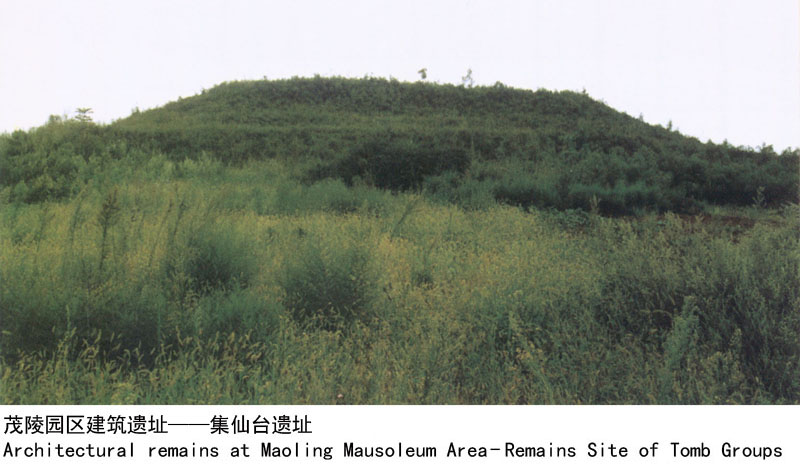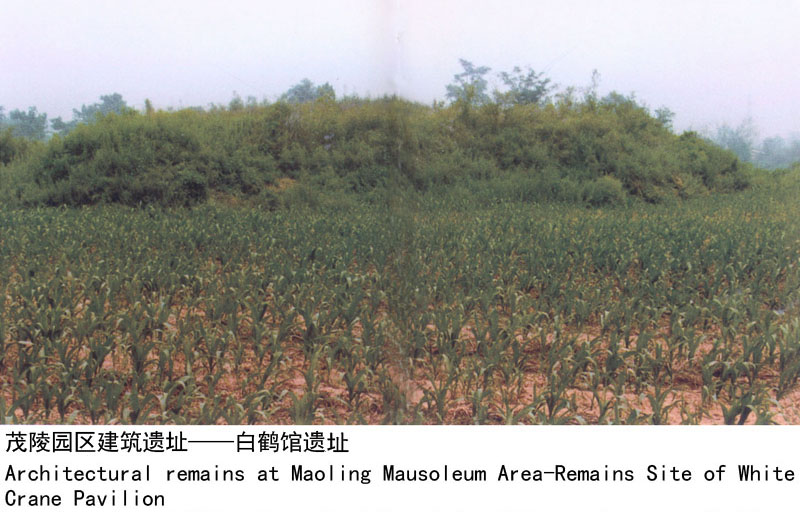第一章 二、茂陵陵园的典型性
王志杰
在西汉11座皇帝陵中,唯茂陵的形制,史籍记载为详,具有突出的典型性。近两年来,陕西省考古研究院对茂陵周围进行了大面积考古钻探,发现茂陵从葬坑多达400余处。汉武帝陵园以内、封土以外分布有从葬坑150座,其中最长者98.5米,宽度多在4米以上;茂陵陵园以外,有规律分布的从葬坑244座,分有4区,其中东区30座,南区69座,西区92座,北区53座,这些从葬坑的长度以120米—170米者居多,宽度2米—3米,深度5米—7.5米。
现仅就茂陵地宫的形制,根据史籍记载,择其要点记述于下:
掘圹就是挖墓坑。茂陵墓坑,竖穴直壁,四壁不设台阶,其形长方。墓坑内设有墓室,为放置墓主的棺材而建筑,棺材周围有一层木炭和白膏泥以防潮湿。还在墓坑四周开掘有四道羡门,以便于安葬和放置随葬物品。
(1)梓宫:汉时,帝王的棺,用梓木制作,是皇帝寝身的棺,称“梓宫”。“宫者,生时所居,缘生视死,因以为名”。据《庄子·天下篇》和《荀子·礼论篇》所载:“天子(皇帝)棺七重,……”如将棺椁分别计数,就是天子五棺二椁。
汉武帝的梓宫,是五棺二椁。五层棺木,是放置在墓室后部椁室正中的棺床上。墓室后半部是一椁室,它有两层,内层以扁平立木叠成“门”形,南面是缺口;外层是黄肠题凑。其五棺所用木料,是楸、檫和楠木三种木料,质地坚细,均耐潮湿,防腐性强。
“梓宫”,按汉代葬制,并非只限皇帝专用,太后和皇后,有的也能享受。《汉书·外戚传》载:“共王母与丁姬”的棺均名“梓宫”。此外皇帝的宠臣,死后也有使用“梓宫”的,如霍光死后,宣帝则赐以“梓宫”,并以皇帝礼葬之。
(2)黄肠题凑:所谓“黄肠题凑”,“以柏木黄心,致垒棺外,故曰黄肠。木头皆内向,故曰题凑”。据史籍载,天子死后,所制作的黄肠题凑,表面打磨光滑,颇费人工,要由长90厘米,高、宽各10厘米的黄肠木15880根,堆叠而成。
(3)便房:从墓道到“梓宫”,要经过便房。《后汉书·礼仪志下》有一段叙述皇帝进入墓室的情况,讲得比较清楚:“羡道开通,皇帝谒便房,太常导至羡道,去杖,中常侍受,至柩前,谒,伏哭止如仪。辞,太常导出,中常侍授杖,升车归宫。”这里所说的“柩前”,即是“梓宫”之前。
“便房”的作用和目的,为的是“藏中便坐也”。《汉书·霍光传》颜注引服虔曰:“便坐,谓非正寝,在于旁侧可以延宾者也。”从房内陈置的随葬物品来谈,可以意识到“便房”当是模仿生人居住和宴飨之所。将其生前认为最珍贵的物品与死者一起殉葬到坟墓中,以便他在幽冥中享用。
“便房”也不是汉武帝葬时所专用,受宠的人或勋臣也赐以便房,如后来的霍光死了,宣帝则赐以“便房”、“黄肠题凑”各一具。
(4)地宫:茂陵这座“金字塔”,在高大的夯土封冢之下,是它的核心建筑——地宫,称为“方中”。张汤调任茂陵尉,他亲自抓的一项具体工程就是“方中”建设。这方中内部一定是个丰富多彩、无奇不有的世界。
茂陵地宫占地一顷,深十三丈(约合39米)。内置梓宫、黄肠题凑、便房、堂坛、墓道、羡门、甬道等,这些都属于地宫建置,不属于随葬品。地宫中的墓道十分开阔,可容六匹硕马并排驾车通行。地宫中的堂坛高三丈,用以摆放奇器异珍。
B Typical Characteristics of Maoling Mausoleum Area
Only the Maoling Mausoleum bears prominent typicality among the 11 counterparts of the Han Dynasty(206 B.C.-220 A.D.).In the recent two years,workers from Shaanxi Archaeological Institute have discovered over 400 burial pits at the Maoling Mausoleum Area,based on large-scale excavation in its vicinity.Within the scope of the Maoling Mausoleum Area spread 150 burial pits,among which the longest length reaches 98.5m.Most pits are measured over 4m in width.Beyond that scatter 244 burial pits separated into 4 areas: 30 to the east,69 to the south,92 to the west and 53 to the north.The majority of them is measured 120-170m long,2-3m wide and 5-7.5m deep.
Based on the historical records,the crypt at the Maoling Mausoleum was described as follows:
The coffin pit was shaped in oblong,walls upright without steps.The pit had the coffin chamber built for the coffins to be placed in,with a layer of charcoal and gesso around the coffins to resist moisture.Each side of the pit had a grave door for convenience of the coffins and burial objects to be sent in.
(a)coffin chamber
In the Han Dynasty coffins for an emperor were made of Chinese catalpa.Emperor Wudi,when dead,had five coffins and two outer coffins exclusively for him.The five coffins were placed on the bier at the center in the rear of the coffin chamber.In accordance with the burial system in the Han Dynasty,not only emperors but also empresses and dowagers could be treated such way after death.Moreover,emperor's favorite official,e.g.,Huo Guang was so buried after death,too.
(b)cypress-encircled coffins
The coffins were encircled by piling up 15880 polished cypress logs of 90cm long,10cm wide and 10cm high around.The five coffins were made of Chinese catalpa,sassafras or nanmu belonging to hardwood of moisture-proof and anti-erosion.
(c)reception room
The reception room was a place located on the way from the grave path to the coffin camber.The place had what the deceased had thought of the most valuable objects,which were buried into the grave in hope for enjoyment by the dead in the nether world.
(d)crypt
The crypt of the Maoling Mausoleum took up an area of one hectare with a depth of 13 zhang(Chinese unit of length equaling to 3.3333m).It had coffin chamber,burial of 15880 polished cypress logs of 90cm long,10cm wide and 10cm high to encircle the coffins,reception room,ceremonial altar,grave path and grave door,apart from luxurious and queer burial objects on the altar.The path leading to the coffin chamber was wide enough for a carriage drawn by six horses to go through.


茂陵文物鉴赏图志/王志杰著.—西安:三秦出版社,2012.